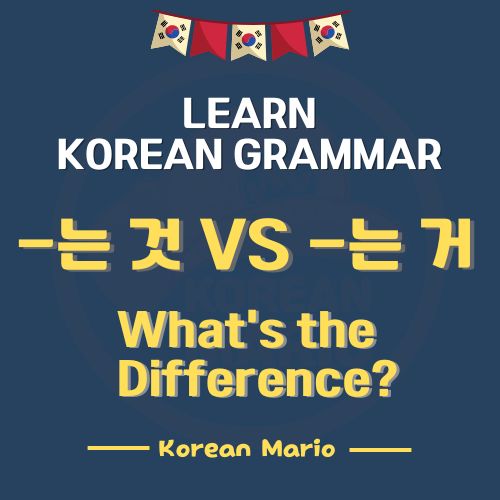V-는 것-If you’re learning Korean, you’ve probably seen “-는 것” and “-는 거” used in sentences. They seem similar, but do they mean the same thing? The short answer: yes, but with some differences in usage!
In this post, I’ll explain what they mean, how they’re used, and when to use each one naturally—so you can sound more like a native Korean speaker!

1. What Do “V-는 것” and “V-는 거” Mean?
Both “-는 것” and “-는 거” come from the Korean word “것”, which means “thing” or “fact.” They are used to turn verbs into nouns (nominalization).
For example:
- 먹는 것 → “Eating (something)”
- 공부하는 것 → “Studying (something)”
- 자는 것 → “Seeling (something)”
- 운동하는 것 → “Working out (something)”
- 기다리는 것 → “Waiting (something)”
- 기다리는 것 → “Waiting (something)”
- 사는 것 → “Living (something)”
<in a Sentence>
1️⃣ 책 읽는 것은 재미있어요.
→ “Reading books is fun.”
2️⃣ 새로운 언어를 배우는 것은 어려워요.
→ “Learning a new language is difficult.”
3️⃣ 아침에 일찍 일어나는 것은 힘들어요.
→ “Waking up early in the morning is hard.”
4️⃣ 좋아하는 음악을 듣는 것은 기분이 좋아요.
→ “Listening to my favorite music makes me feel good.”
5️⃣ 친구들과 함께 여행하는 것은 행복해요.
→ “Traveling with friends is happy/enjoyable.”
💡 Tip: In English, these sentences often use “-ing” verbs, but in Korean, we use “-는 것” to turn actions into nouns. This makes them work just like English gerunds (e.g., “reading,” “listening”).
So, these expressions help describe actions as concepts, just like gerunds (“eating,” “studying”) in English.
2. “V-는 것” vs. “V-는 거” (Formal vs. Casual)
| Expression | Meaning | Usage | Example Sentence |
|---|---|---|---|
| “-는 것” | “The act of ~ing” | More formal, used in writing or polite speech | 운동하는 것은 건강에 좋아요. → “Exercising is good for your health.” |
| “-는 거” | “The act of ~ing” (spoken form) | More casual, used in daily conversations | 운동하는 거 좋아해요? → “Do you like exercising?” |
🔹 Key Takeaway:
“-는 거” is just a shortened (spoken) version of “-는 것.” Native speakers often use “-는 거” in spoken Korean because it sounds more natural and casual.
3. Examples in Everyday Sentences
| English | Formal (-는 것) | Casual (-는 거) |
|---|---|---|
| “I like listening to music.” | 음악 듣는 것이 좋아요. | 음악 듣는 거 좋아요. |
| “Is studying Korean fun?” | 한국어 공부하는 것은 재미있어요? | 한국어 공부하는 거 재미있어요? |
| “Watching movies is my hobby.” | 영화 보는 것이 제 취미예요. | 영화 보는 거 제 취미예요. |
As you can see, “-는 것” sounds more proper, while “-는 거” sounds more natural in speech.
4. When to Use “V-는 것” and “V-는 거” Naturally
- Use “-는 것” in formal situations (writing, presentations, polite speech).
- Use “-는 거” in casual conversations (talking to friends, texting, informal speech).
🔹 Native Speaker Tip:
Most Koreans use “-는 거” in daily life because it’s easier to say! If you’re not sure which one to use, “-는 거” is a safe choice in casual situations.
5. Quick Quiz! (Test Yourself)
Which form (-는 것 or -는 거) would you use in these sentences?
1️⃣ (Formal speech) Studying Korean is fun.
➡ _______ 공부하는 ___이 재미있어요.
2️⃣ (Casual conversation) Do you like cooking?
➡ 요리하는 ___ 좋아해요?
3️⃣ (Writing an essay) Exercising is important.
➡ 운동하는 ___은 중요해요.
💡 Check your answers:
1️⃣ 것 | 2️⃣ 거 | 3️⃣ 것
Conclusion: Speak Like a Native!
Both “V-는 것” and “V-는 거” mean the same thing, but “-는 거” is more common in everyday speech.
👉 If you’re speaking casually → Use “-는 거”
👉 If you’re writing or being polite → Use “-는 것”
💬 Now it’s your turn! Try making your own sentences with “-는 것” and “-는 거” in the comments below! 🚀
If you enjoyed this lesson, check out KoreanMario.com for more fun and easy Korean grammar lessons! 🇰🇷💙
Let’s study the next grammar!👇
Korean Grammar N 때문에, A/V-기 때문에 Because
Table of Contents

